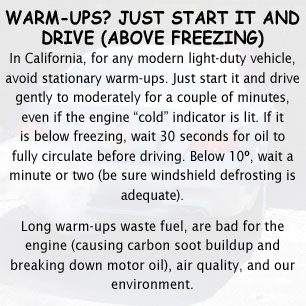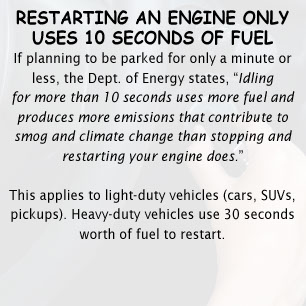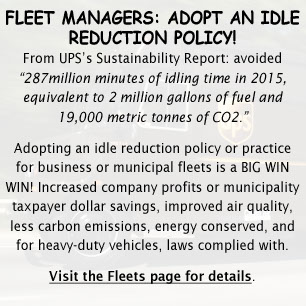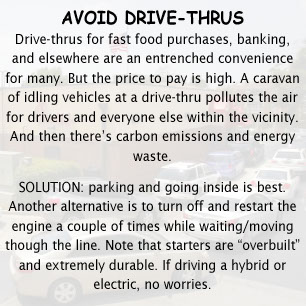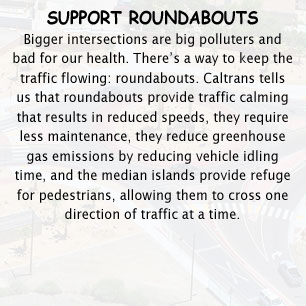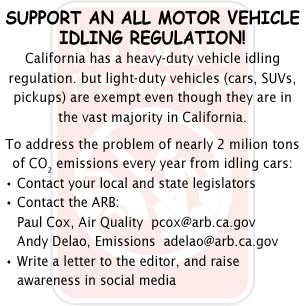Tips
When and how long should a vehicle idle?
LIGHT-DUTY: CAR, SUV, VAN, PICKUP
For any light-duty vehicle, 1996 model or newer, assuming properly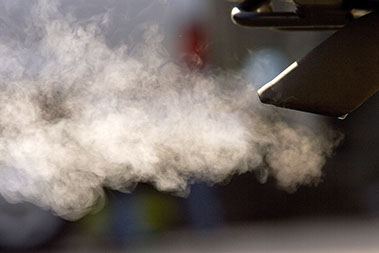 maintained, the overall stationary warm-up period is just 30 seconds, even in winter. The U.S. Dept. of Energy states it best: "Minimize idling your car to warm it up. Most manufacturers recommend driving off gently after about 30 seconds. The engine will warm up faster being driven, which will allow the heat to turn on sooner, decrease your fuel costs, and reduce emissions."
maintained, the overall stationary warm-up period is just 30 seconds, even in winter. The U.S. Dept. of Energy states it best: "Minimize idling your car to warm it up. Most manufacturers recommend driving off gently after about 30 seconds. The engine will warm up faster being driven, which will allow the heat to turn on sooner, decrease your fuel costs, and reduce emissions."
EXCEPTIONS: 1. Do not drive unless defrosting is adequate. 2. In temperatures below 10 degrees F (-12 degrees C) warm up while parked for one to two minutes (due to thickened motor oil). 3. For infants and frail elderly passengers, allow up to several minutes.
DRIVE GENTLY TO CONTINUE THE WARM UP. Driving gently to continue warming up places virtually the same load on a cold engine that is idling, yet allowing a gain in fuel economy. But more importantly non-engine moving parts like the transmission, bearings, catalytic converter, steering, and tires warm up with the engine when driving; they will not do so when idling. Note for vehicles equipped with a temperature gauge or light indicator: this indicates the engine is warming up. It will go off as soon as the engine reaches normal operating temperature. This does not mean, however, that a vehicle must remain stationary during this period. It just means not to exceed warm up RPMs; driving gently will allow RPMs to stay low until warm up is complete.
HOW LONG SHOULD A WARMED UP VEHICLE IDLE? The Dept. of Energy Argonne National Laboratory concludes: "Idling for more than 10 seconds uses more fuel and emits more CO2 than engine restarting". However, the break-even time to offset any potential incremental maintenance costs to the starter or battery is 30 seconds. So, as a guideline, if you're stopped out of traffic for more than 30 seconds turn off the engine. TIP: Keep blankets or afghans in your vehicle to use when parked in cold weather to help avoid excessive idling.
MYTH: "LETTING A CAR IDLE IS NECESSARY FOR THE ENGINE." FACT: Prolonged idling causes engine wear. According to Oak Ridge National Laboratory Summary of OEM Idling Recommendations from Vehicle Owner’s Manuals, "Excessive idling can create engine wear and carbon soot buildup in the engine and components" and "Excessive idling can affect the life of engine oil". It also shortens the life of spark plugs and exhaust system. Many auto manufacturers owner's manuals advise limiting warm-up idling, such as 2013 BMW 3 Series, 2015 Ford F-250 Power Stroke diesel, 2015 Ram 1500-2500-3500, and all 2015 Nissans. Excessive idling places vehicles under a Severe Duty maintenance schedule. Linda Gaines, an Argonne transportation systems analyst, explains why prolonged stationary warm ups in winter are rarely necessary. NOTE: avoid using remote vehicle starters which encourage excessive idling.
THE CONVENIENCE & COMFORT FACTOR. Some of these tips and information make suggestions that can involve giving up a convenience or comfort, which can be a very personal thing. For instance, when parked on a warm to hot day, is there a willingness to shut off A/C and the engine and open windows instead (or going inside a building) to use a smartphone? Or to shut off and restart the engine once or twice in a drive-thru (or parking and going into the place of business)? Or to forgo a remote starter? This can be an inconvenience, even a sacrifice. But the cost of convenience idling is high, especially collectively. Climate change that has been brought on, in part from human activities including unnecessary idling, will worsen as we allow vehicles to idle to seek relief from the heat. For the sake of our planet, we must break this vicious cycle.
One solution is to drive a vehicle that seldom idles or not at all, like a hybrid or electric. In fact, one can be pretty guilt-free letting a hybrid run with the A/C on while parked. According to testing on a 2015 Toyota Prius for 20 minutes with the ignition on, the A/C set to 74 degrees, Recirc on, 91 degrees outside, the Prius ran in battery mode alone for 17 of 20 minutes; even at 100 degrees outside, it ran in battery mode alone for 13 of 20 minutes.
It is strongly recommended to seek alternatives to being in a parked vehicle in weather extremes. But if there is no place else to go, for factors of safety and health, idling may have to occur (although it can in alternating on-off cycles). This is especially true if there is an elderly person, child, or pet in the vehicle. On a very hot day, especially if not parked in the shade, the vehicle will need to idle with windows closed and A/C on.
NOTE: For safety reasons Idle-Free California strongly recommends not shutting off engines in normal traffic such as at long red lights. It is, however, recommended to shut off engines in prolonged back ups, road construction zones, railroad crossings, and border crossings.
MEDIUM- AND HEAVY-DUTY DIESEL
STATIONARY WARM UP. The overall stationary warm-up period is three to five minutes. In colder weather, more idling time may be necessary, especially for non-garaged vehicles. Block heaters and other idling reduction equipment can reduce cold weather warm-up idling.
three to five minutes. In colder weather, more idling time may be necessary, especially for non-garaged vehicles. Block heaters and other idling reduction equipment can reduce cold weather warm-up idling.
OVERALL IDLING GUIDELINES. The Oak Ridge National Laboratory Operations Summary of OEM Idling Recommendations from Vehicle Owner’s Manuals provides medium- and heavy-duty idling guidelines:
MEDIUM-DUTY IDLING SUMMARY
• Avoid excessive idling (Idling beyond 5-15 minutes is excessive)
• Extended idling wastes fuel and causes reduction in fuel economy
• Excessive idling can create engine wear and carbon soot buildup in the engine
and components
• Idle time at cooldown is only required if vehicle operated under extended, high
power conditions (as recommended in manual)
HEAVY-DUTY IDLING SUMMARY
• Avoid excessive idling (idling beyond 5-15 minutes is excessive)
• Avoid idling for more than 3-5 minutes at start-up
• Extended idling wastes fuel and causes reduction in fuel economy
• Excessive idling can create engine wear and carbon soot buildup in the engine and components
• Idling produces sulfuric acid which can eat into engine surfaces and components
• Idle time at cooldown is only required if vehicle operated under extended, high power conditions (as recommended in manual)
ADDITIONAL INFORMATION ON MEDIUM- & HEAVY-DUTY IDLING - INCLUDING ENGINE MANUFACTURER QUOTED SOURCES: Visit the Heavy-Duty page.

